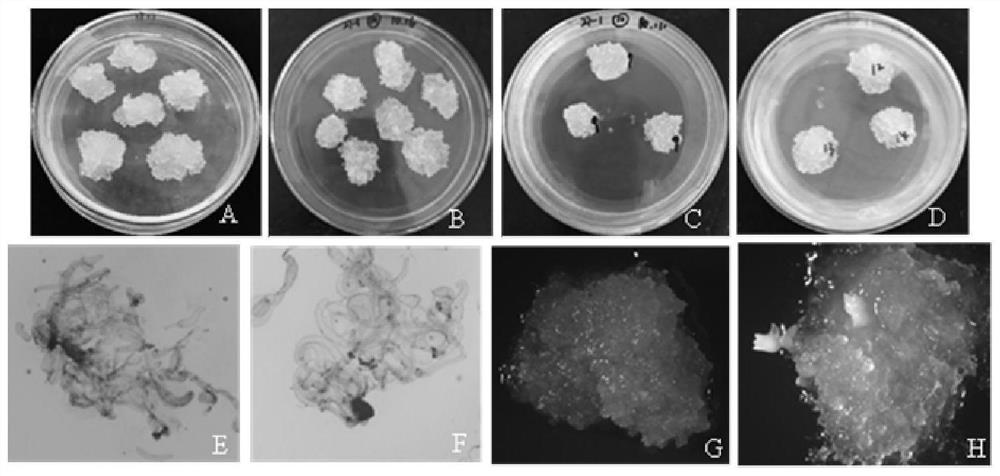Cryogenic preservation method of embryogenic callus of pine needle brown spot disease resistant Pine slash
A technology of embryogenic callus and cryopreservation, which is applied to the preservation of plants, gardening methods, botanical equipment and methods, etc., to achieve good growth status and improve the effect of cryopreservation
- Summary
- Abstract
- Description
- Claims
- Application Information
AI Technical Summary
Problems solved by technology
Method used
Image
Examples
Embodiment 1
[0026] Example 1 Ultra-low temperature preservation of resistant slash pine embryogenic callus
[0027] 1 Pretreatment for cryopreservation
[0028] 10-12 days after subculture (the 24th time), take 0.3g pine embryogenic callus, place it on the hyperosmotic medium that has added 0.5mol / L sucrose and carry out pre-cultivation, set different culture time (12, 24, 36, 48h). Then, using different concentrations of DMSO (2.5, 5, 10, 15%), different concentrations of PEG4000 (0, 5, 10, 15%) and different concentrations of sucrose (0, 0.4, 0.5, 0.6mol / L) as Cryoprotectant pretreatment of callus. See Table 1 for details.
[0029] 2 cryopreservation
[0030] Place the pre-cultured embryogenic callus in a freezing tube, place the freezing tube with cryoprotectant in a programmed cooling device, set the cooling program, first drop from room temperature to 0°C, then -1°C / The temperature was lowered to -80°C at a rate of 1 min, and stored at -80°C for 30 minutes, and immediately put ...
Embodiment 2
[0052] Example 2 Determination of recovery of slash pine embryogenic callus after thawing
[0053] 1 Proliferation and maturation of callus after thawing
[0054] The washed callus was transferred to the LP proliferation medium, and the growth was resumed in the dark at a room temperature of 23±2°C, and the growth recovery of the callus was observed every 7 days. The recovered slash pine callus was transferred to the maturation medium, and the somatic embryo maturation of the callus was observed.
[0055] 2 Culture conditions and data analysis
[0056] Proliferation medium is LP+1.0mg / L NAA+0.3mg / L 6-BA+0.3mg / L 6-BA+15g / L maltose+6.5g / L agar, pH=5.8. The maturation medium is LP+10mg / L NAA+130g / L PEG8000+60g / L maltose+3g / L phytogel, pH=5.8. Cultivate in the dark at a temperature of 23±2°C.
[0057] 3 Recovery of callus tissue after thawing
[0058] As can be seen from Table 4, after the treated callus was frozen for 10 days, it was taken out and thawed out, and 14 of the 1...
PUM
 Login to View More
Login to View More Abstract
Description
Claims
Application Information
 Login to View More
Login to View More - R&D
- Intellectual Property
- Life Sciences
- Materials
- Tech Scout
- Unparalleled Data Quality
- Higher Quality Content
- 60% Fewer Hallucinations
Browse by: Latest US Patents, China's latest patents, Technical Efficacy Thesaurus, Application Domain, Technology Topic, Popular Technical Reports.
© 2025 PatSnap. All rights reserved.Legal|Privacy policy|Modern Slavery Act Transparency Statement|Sitemap|About US| Contact US: help@patsnap.com



